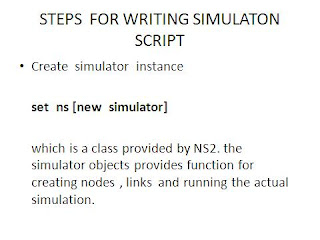WHAT IS NS2
Network Simulator 2
NS2 is an open-source simulation tool that mainly runs on Linux. It is a discreet event simulator targeted at networking research. Specifically ns-1, ns-2 and ns-3 these are various version of NS simulators are used in the simulation of routing, multicast protocols and IP protocols, such as UDP, TCP, RTP and SRM over wired and wireless (local and satellite)networks, MANET, Cellular Network etc. It has many advantages that make it a useful tool, such as support for multiple protocols and the capability of graphically detailing network traffic. It also support very complex network topology for simulation. Additionally, NS2 supports several algorithms in routing and queuing. LAN routing and broadcasts are part of routing algorithms. Queuing algorithms include fair queuing, deficit round-robin and FIFO, RED etc. So NS is used to simulate real world networking enviroment before implementing in the real world , which also provide a cost effective simulation enviroment.
NS2 started as a variant of the REAL network simulator in 1989. REAL is a network simulator originally intended for studying the dynamic behavior of flow and congestion control schemes in packet-switched data networks.
Currently NS2 development by VINT group is supported through Defense Advanced Research Projects Agency (DARPA). NS2 is available on several platforms such as FreeBSD, Linux, SunOS and Solaris. NS2 also builds and runs under Windows. There are other some network simulator tool avilable such as Omnet++, GloMoSim, NetSim etc, But NS is more populer widely in different university and in different organization because of its flexibility.
NS2 started as a variant of the REAL network simulator in 1989. REAL is a network simulator originally intended for studying the dynamic behavior of flow and congestion control schemes in packet-switched data networks.
Currently NS2 development by VINT group is supported through Defense Advanced Research Projects Agency (DARPA). NS2 is available on several platforms such as FreeBSD, Linux, SunOS and Solaris. NS2 also builds and runs under Windows. There are other some network simulator tool avilable such as Omnet++, GloMoSim, NetSim etc, But NS is more populer widely in different university and in different organization because of its flexibility.
Lets start with Components of NS2 structure :
>> ns itself as a intrepeter to covert Tcl command into real object scenario.
Three important term in above just think :
Intrepeter : Which produce output from a set of code without compilation.
Tcl : A tool command based language supported by ns2.1b9a to ns-2.34. But ns-3 support python.
Real object : A simulation object which is comapred with the real enviroment scenatio.
>> nam - network animator
Which visualize the simulation scenario in graphical format.
>> Xgraph- one of the postprocessing tool to plot graph.
But before using NS2 its necessary to learn basic about Tcl.
TCL will be explained in the next article............wait........
YOU CAN FOLLOW THIS LINK FOR TCL SCRIPT...
HOW TO INSTALL NS-2.34 ON FEDORA-10:
You can install NS2 [Network Simulator 2] in Fedora 10 (fc10) by following some simple steps.
1.
Download ns-allinone-2.34
Extract ns-allinone-2.34.tar.gz using Archive Manager
Create an Empty file named it do-all in directory ns-allinone-2.34.
Open terminal from top panel [Applications -> System Tools -> Terminal]
Change the directory. Suppose you have extracted ns-allinone-2.34.tar.gz in /root/Desktop, then write cd Desktop/ns-allinone-2.34? without cotes in terminal
Change the permission of the file do-all by typing chmod 777 do-all in terminal & press Enter.
Write the following lines in do-all file
cd `pwd`
./install
cp ns-2.34/ns /bin
cp nam-1.14/nam /bin
cp xgraph-12.1/xgraph /bin
Run the file. Write ./do-all & Press Enter.
Thats all. U can run ns by writing nsithout cotes in terminal.
WAIT 5 MINUTES
2 PATH SETUP:
$ gedit ~/.bashrc
# LD_LIBRARY_PATH
OTCL_LIB=/home/manas/ns-allinone-2.34/otcl-1.14
NS2_LIB=/home/manas/ns-allinone-2.34/lib
X11_LIB=/usr/X11R6/lib
USR_LOCAL_LIB=/usr/local/lib
export LD_LIBRARY_PATH=$LD_LIBRARY_PATH:$OTCL_LIB:$NS2_LIB
:$X11_LIB:$USR_LOCAL_LIB
# TCL_LIBRARY
TCL_LIB=/home/manas/ns-allinone-2.34/tcl8.4.18/library
USR_LIB=/usr/lib
export TCL_LIBRARY=$TCL_LIB:$USR_LIB
# PATH
XGRAPH=/home/manas/ns-allinone-2.34/bin:/home/manas/ns-allinone-2.34/tcl8.4.18/unix:/home/manas/ns-allinone-2.34/tk8.4.18/unix:/home/manas/ns-allinone-2.34/xgraph-12.1/
NS=/home/manas/ns-allinone-2.34/ns-2.34/
NAM=/home/manas/ns-allinone-2.34/nam-1.14/
export PATH=$PATH:$XGRAPH:$NS:$NAM
3 VALIDATE IT :
go to cd ns-2.34
./validate
WAIT 1 HOUR 23 MINUTES
4 $ source ~/.bashrc
check file >>>
5 multiple interface and direcctional antenna support :
cd $ns2.34
patch -p1 < dir-antenna.patch patch -p1 < multi-if.patch ./configure --with-otcl=../otcl-1.13 --with-tclcl=../tclcl-1.19 make 6 VALIDETE IT ./validate WAIT 1 HOUR 20 MINUTES
NOW NS2.34 IS READY TO USE
FOR ANY PROBLEM CONTACT :
BY
MANAS PRATIM SARMA
email: sarma32@gmail.com
ph: 09435239353



























